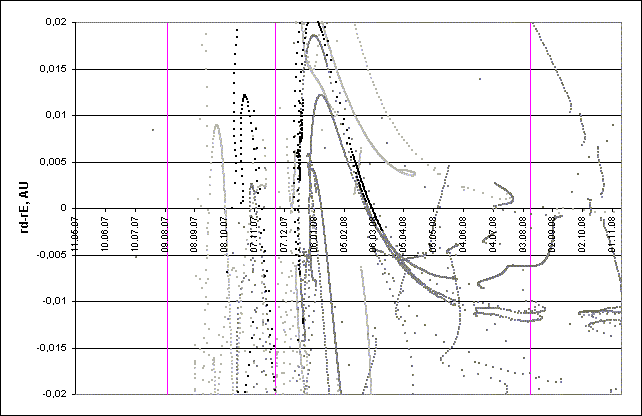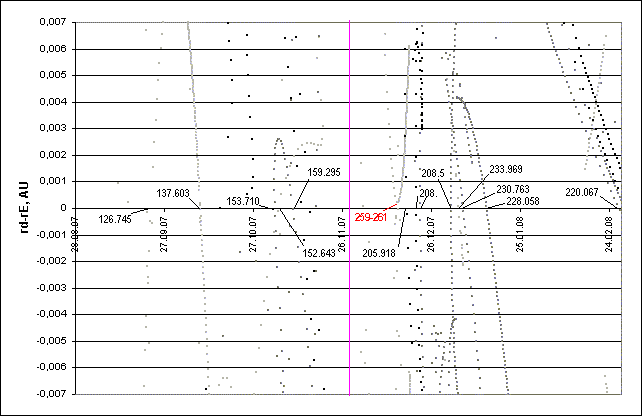72P-ids: prediction of activity
to the list of predictions
Introduction
Computation characteristics
We'd like to introduce the results of simulation of the meteor stream produced by the comet 72P Denning-Fujikawa aimed to the prediction of shower activity in 2007. The simulation was made for the trails of latest 10 revolutions, i.e, from the 1908 trail. The Author used the program by S. Shanov and S. Dubrovsky "Comet's Dust 2.0" to calculate orbital elements of ejected meteor particles. To estimate expected ZHRs for different encounters the model by E. Lyytinen and T. van Flandern given in their paper [4] was used with some Author's alterations made in order to adopt the model for ejection velocity (Vej) instead of da0 (difference in a-semimajor axis) and to convert the model from the Leonid stream (for which it was originally created) to the 72P-ids. The computation considered only gravitational forces The following parts of trails were computed: the first 10 rev. trails for ejection velocities [-50;100] m/s.
Results
The Fig. 1 below shows the distribution of 72P dust trails in the vicinity of the Earth's orbit within the period of 11.05.2007 - 10.11.2008. The vertical axis shows the minimal distance between trails particles and the Earth's orbit (the current orbit of 72P has two minimal distances to the Earth's orbit - about August 11 and November 28). So far, the Fig. 1 displays the moments of passage of minimal distances to the Earth's orbit for various trails and particles and these distances themselves.
Introduction
Computation characteristics
We'd like to introduce the results of simulation of the meteor stream produced by the comet 72P Denning-Fujikawa aimed to the prediction of shower activity in 2007. The simulation was made for the trails of latest 10 revolutions, i.e, from the 1908 trail. The Author used the program by S. Shanov and S. Dubrovsky "Comet's Dust 2.0" to calculate orbital elements of ejected meteor particles. To estimate expected ZHRs for different encounters the model by E. Lyytinen and T. van Flandern given in their paper [4] was used with some Author's alterations made in order to adopt the model for ejection velocity (Vej) instead of da0 (difference in a-semimajor axis) and to convert the model from the Leonid stream (for which it was originally created) to the 72P-ids. The computation considered only gravitational forces The following parts of trails were computed: the first 10 rev. trails for ejection velocities [-50;100] m/s.
Results
The Fig. 1 below shows the distribution of 72P dust trails in the vicinity of the Earth's orbit within the period of 11.05.2007 - 10.11.2008. The vertical axis shows the minimal distance between trails particles and the Earth's orbit (the current orbit of 72P has two minimal distances to the Earth's orbit - about August 11 and November 28). So far, the Fig. 1 displays the moments of passage of minimal distances to the Earth's orbit for various trails and particles and these distances themselves.

Fig. 1. Space-temporal projection of 72P-ids trails parts onto their minimal distance passages (correspondence between colours of the particles and their ejection velocities can be seen here).
For the year 2007 we can see concentration of trails around the time of second minimum distance between the comet and Earth orbit. This part of the Fig. 1 is given on the Fig.2 in more detailed scale. It shows the distribution of 72P dust trails in the vicinity of the Earth's orbit within the period of 28.08.2007 - 28.02.2008. The vertical axis shows the minimal distance between trails particles and the Earth's orbit. So far, the Fig. 2 displays the moments of passage of minimal distances to the Earth's orbit for various trails and particles and these distances themselves. Also, the points of intersection between the Earth's orbit and regular trail parts of the comet 72P are marked with their solar longitudes.

Fig. 2. Space-temporal projection of 72P-ids trails parts onto their minimal distance passages (correspondence between colours of the particles and their ejection velocities can be seen here).
One of a number intersections is of interest for us. Its solar longitudes interval is given in red print. This is 1952 trail, in our case its central line doesn't intersect the Earth's orbit, but its particles with ejection velocities within interval (+71.9;+72.1) m/s pass at the distances as low as 0.00021 AU to the Earth's orbit. The encounter happens during December 13-15 at solar longitudes of 259-261° (December 11-13). So far, in our opinion, during the perion of 11-13 December 2007 there is a small chance for occurance of low activity from the stream of the comet 72P (its 1952 trail). If the activity happens, meteor brightness is expected to be very low, more prominent action is likely in radiorange. The radiant should be located at RA=274°, Dec=-22°. It is only 13° to the East from the Sun, that makes radioobservations the single possible way of detecting the shower activity.
Conclusions
In 2007 we have a small chance of activity from meteor stream prodiced by the comet 72P. During the period of December 11-13 a low enhancement of meteor activity with low average brightness, mostly in radiorange, can happen. The radiant is RA=274°, Dec=-22°. The closeness of the radiant to the Sun makes the shower a daylight one with radioobservations only possible.
References
1. "Comet's dust 2.0" program by S. Shanov and S. Dubrovsky. [Used for orbital computations.]
2. Information from Gary W. Kronk's page http://www.maa.agleia.de
3. IMO Meteor Shower Calendar 2006 http://www.imo.net/calendar/russian/2006/spring.
4. Lyytinen E, van Flandern T. "Predicting the strength of Leonid outbursts", 2000, Icarus, P. 158-160.
In 2007 we have a small chance of activity from meteor stream prodiced by the comet 72P. During the period of December 11-13 a low enhancement of meteor activity with low average brightness, mostly in radiorange, can happen. The radiant is RA=274°, Dec=-22°. The closeness of the radiant to the Sun makes the shower a daylight one with radioobservations only possible.
References
1. "Comet's dust 2.0" program by S. Shanov and S. Dubrovsky. [Used for orbital computations.]
2. Information from Gary W. Kronk's page http://www.maa.agleia.de
3. IMO Meteor Shower Calendar 2006 http://www.imo.net/calendar/russian/2006/spring.
4. Lyytinen E, van Flandern T. "Predicting the strength of Leonid outbursts", 2000, Icarus, P. 158-160.